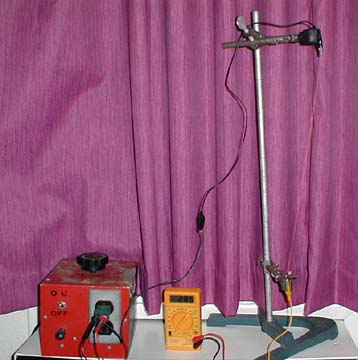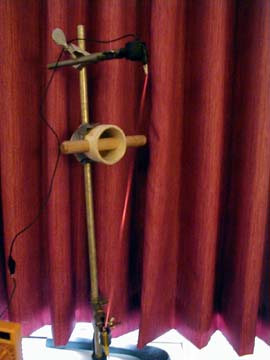You're toast!

An AC Variac provides 28 volts across 28 cm of nichrome wire.
The wire glows.
You're toast!

An AC Variac provides 28 volts across 28 cm of nichrome wire.
The wire glows.
Introduction
When you blow on a small incandescent wire you can cool it enough that it ceases to emit light.
Material
Assembly
Build the nichrome wire holder:
- Attach the test tube holders to the ring stand about 24 cm apart.
- Squeeze one alligator clip in the upper holder.
- Clip the alligator clip to the nichrome wire.
- Clip the other alligator clip to the bottom of the wire.
- Use the bottom test tube holder to gently hold the bottom alligator clip.
- Optional, you could create your own wire holder using PVC tubing.
Make sure the Variac or other power supply is turned off and unplugged.
Connect the alligator clips to the power supply.
To Do and notice
Plug in the power supply and gradually turn up the voltage until the nichrome wire just begins to glow.
Warning: Do not exceed 24 volts! This is
the limiting voltage for your safety.
No one with intact skin has ever been electrocuted with under 24
volts.
Warning: The wire is hot if you touch it it will burn you.
Warning: Do not heat the wire to yellow-white, it might melt apart.
Notice the yellow orange glow of the nichrome wire.
Blow on the wire.
Notice that where you blow on the wire it becomes dark.
What's Going On?
The wind from your breath cools the wire enough so that it ceases to emit visible light.

An incandescent wire heated by 60 hertz AC is driven into
its second harmonic of oscillation by a nearby magnet.
To Do and Notice
Hold the magnet near one end of the wire.
Grab the bottom alligator clip and change the tension in the wire.
Notice that you can feel the wire vibrating when you hold the alligator clip.
Remove the magnet and the wire stops vibrating.
At some values of tension the wire makes a pattern of light and dark incandescence.
What's Going On?
The 60 cycle alternating current in the wire is pushed on by the magnetic field from the magnet.
When your tension in the wire produces a fundamental frequency of oscillation for the wire or one of its harmonics that is 60 cycles the wire will be driven into a standing wave by the forces of the magnet on the electric current in the wire.
For example when the fundamental frequency of the wire is 30 cycles, the 60 cycle frequency of the power line will drive it in its second harmonic.
References
This Snack is based on the Exploratorium exhibit by Eric Thorgerson.
|
Scientific Explorations with Paul Doherty |
|
10 July 2000 |